Dedicated Software Development Team: The Full Guide 2025
A dedicated software development team is a flexible outsourcing model in which businesses partner with a specialized team of developers to focus solely on long-term projects. This ensures efficient, scalable, and targeted software solutions.
Hiring a dedicated team brings key advantages: substantial cost savings over in-house hiring, rapid scalability, and specialized expertise that might be missing internally. Founded in 2016, Groove Technology has provided high-performing software teams across Australia, Asia, and Europe. With over a decade of experience, we simplify outsourcing, offering businesses reliable, budget-friendly, and expert-driven solutions. Explore how our dedicated teams can transform your software development approach.

What Is The Dedicated Software Development Team Model?
The dedicated software development team is a group of skilled experts aligned to work together. This team becomes a long-term partner, fully committed to the client's goals, without juggling tasks for other clients. Unlike traditional in-house teams, clients are freed from handling administrative duties such as HR, taxes, and benefits, as the outsourced team takes care of all these responsibilities.
With this model, businesses can focus on strategic decisions while the development team handles technical operations. You also gain the flexibility to scale the team up or down based on the project's needs, making it ideal for large, complex tasks like mobile app development, cloud solutions, or blockchain.
The ability to access a global talent pool ensures that you can hand-pick specialists suited to your specific requirements, making the dedicated team model highly versatile and efficient.

What Is The Dedicated Software Development Team Structure?
The structure of a dedicated software development team is flexible and tailored to each project's specific goals and requirements. Typically, the core team includes these six key roles:
- Project Manager: Oversees the project, coordinating between stakeholders, ensuring smooth execution, and meeting delivery deadlines.
- Developers: Includes front-end, back-end, full-stack, and mobile developers, each responsible for writing the software across various platforms and technologies.
- UX/UI Designer: Designs the user interface and experience, ensuring that the product is visually appealing and easy to navigate.
- QA Engineer: Tests the software to ensure it functions as expected and meets the defined requirements.
- DevOps Engineer: Manages deployment, infrastructure, and ongoing application monitoring.
- Business Analyst: Analyzes project requirements, ensuring the final product aligns with business goals and client expectations.
The team composition will vary depending on the project's scope, complexity, and specific needs, ensuring optimal results for each unique challenge.
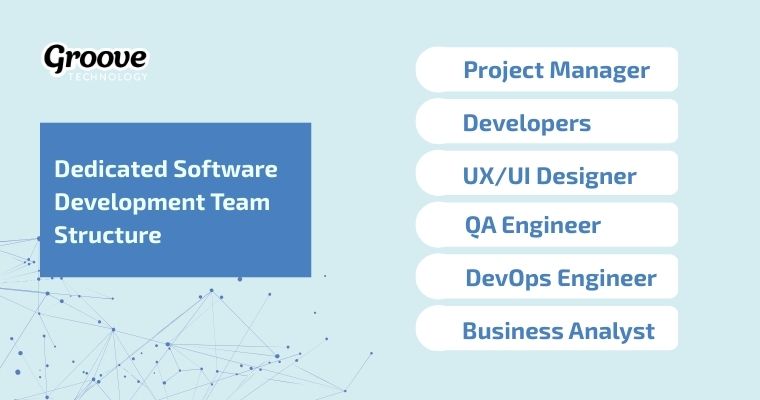
What Roles Does A Dedicated Software Development Team Offer?
At Groove Technology, we offer nine specialized roles in our Dedicated Software Development Teams to ensure your project is in the hands of experts. These roles span various technical and business functions, creating a well-rounded team to handle all your needs.
- Full-Stack Developers: Our team excels at working with technologies like Microsoft Stack/.NET, Python, and Node.js for backend development and React.js or Angular.js for front-end frameworks.
- Web App Developers: We design and build tailored web applications that meet specific business goals, simplifying complex workflows with customized solutions.
- Mobile App Developers: Our engineers specialize in developing native mobile apps for iOS and Android, using React Native to optimize and streamline the development process.
- IoT Developers: Collaborate with our IoT engineers to create interconnected applications that leverage smart devices and data-driven insights for a smarter, more efficient experience.
- DevOps Engineers: Scale your business quickly with our DevOps team, offering services in automation, plugin integration, API development, and more.
- Software Testers: Our testers ensure software reliability and quality through advanced testing techniques, guaranteeing smooth functionality and optimal user experiences.
- UI/UX Designers: Enhance user interactions with our skilled designers who focus on intuitive interfaces and seamless, engaging experiences.
- Business Analysts: Our analysts translate business needs into clear, actionable specifications, ensuring that development aligns perfectly with your goals.
- Project Managers: Efficient project management ensures that your project stays on track, within budget, and meets deadlines with seamless execution.
Benefits of Hiring a Dedicated Software Development Team
To answer the question “Why outsource software development?”, these 6 benefits clearly highlight how outsourcing can provide flexibility, access to global talent, and cost-effective scalability.
- Cost-effectiveness: You only pay for the specific team members you need, eliminating costs associated with hiring, training, salaries, taxes, office rent, and equipment. Experienced professionals lead to quicker, more accurate project completion, ensuring that budgets are used efficiently and delays are minimized.
- Relevant expertise: With access to a global talent pool, you can hire up-to-date specialists with industry best practices and the latest technologies. Developers with experience in similar projects can quickly identify and tackle challenges, enhancing the overall quality of the software.
- Flexibility: The team's size, composition, and scope can be easily adjusted based on changing business needs and market conditions. You can quickly scale up or down without needing lengthy recruitment processes, keeping your project aligned with your business objectives.
- Transparent workflow: Tools like Jira, Trello, and ClickUp enable real-time updates and task tracking, allowing for seamless collaboration. Open communication through progress reports and regular calls ensures everyone is aligned, helping the project stay on track.
- Faster time to market: With a dedicated team focusing solely on your project, development accelerates, enabling you to meet deadlines and launch your product more quickly. This focus leads to quicker, more successful product releases.
- Long-term partnership and knowledge retention: A dedicated team develops a deep understanding of your business, goals, and technical needs. This continuity allows for smoother transitions between projects and informed decision-making, ensuring consistent quality over time.
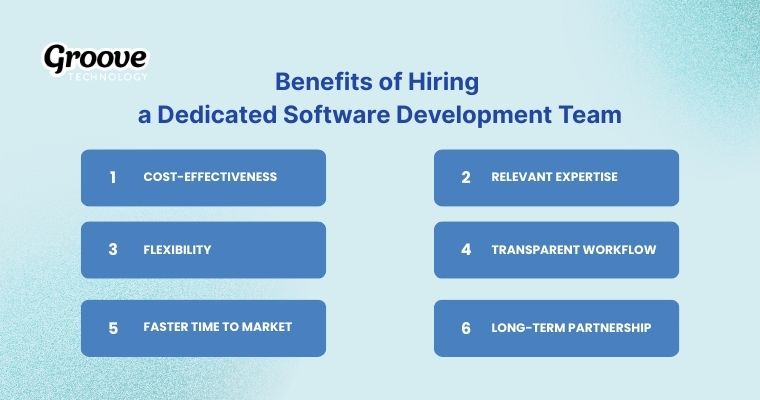
Disadvantages of Hiring a Dedicated Software Development Team
While hiring a dedicated software development team brings numerous advantages, it's also important to consider potential drawbacks. Here are three challenges of software development outsourcing to keep in mind:
- Time zone and communication barriers: When working with a team located in a different time zone, communication delays can occur. Real-time collaboration may be limited, leading to slower feedback loops and potential misunderstandings. Cultural differences and language barriers can also impact clarity and workflow efficiency.
- Complex management: Managing a remote dedicated team requires strong project management skills. You’ll need to coordinate across tools, platforms, and sometimes even languages to keep the team aligned. Without proper oversight, it’s easy for priorities to shift, deadlines to slip, or miscommunication to derail progress.
- Limited flexibility: Dedicated teams are best suited for long-term projects with well-defined goals. If your project scope changes frequently or requires rapid pivots, it may be challenging to adapt quickly. Scaling the team up or down can also take time and incur additional costs compared to more flexible outsourcing models.
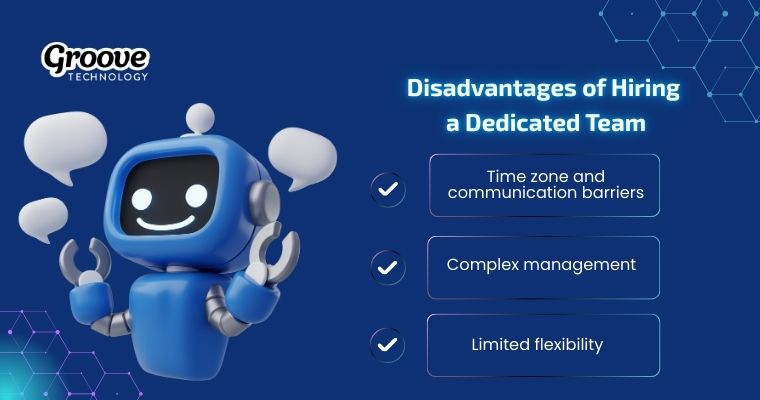
What Are The Key Differences Between A Dedicated Development Team And An In-House Team?
When comparing a dedicated development team to an in-house team, several factors distinguish the two models.
- A dedicated team typically works remotely, often from offshore or nearshore locations, while in-house teams operate locally.
- Dedicated teams are more cost-effective due to lower development rates in offshore regions, whereas in-house teams come with higher costs due to staffing and overhead expenses.
- Additionally, dedicated teams provide access to a broader pool of global talent, but in-house teams offer immediate, direct access for better communication and control.
Here are six key criteria to compare the two models:
| Criteria | Dedicated Development Team | In-house Development Team |
| Location | Works remotely, often in offshore or nearshore areas, such as Latin America or Eastern Europe. | Operates locally, directly in your office. |
| Cost | More affordable due to lower development costs in offshore and nearshore regions. | More expensive due to higher staffing and overhead costs. |
| Team control | Managed remotely by the client with indirect oversight. | Offers direct and immediate control for the client. |
| Developer availability | Access to a global talent pool, bringing diverse expertise. | Limited to the local job market, reducing talent options. |
| Communication | Time zones and language barriers can hinder effective communication. | Seamless communication with face-to-face interaction. |
| Culture | Cross-cultural challenges may arise, but they also offer diverse perspectives. | Easier to foster a strong, cohesive company culture. |
>>> See more: Comprehensive Comparison of Inhouse and Outsourcing Software Development
Is Hiring a Dedicated Software Development Team The Right Approach for Your Business?
The dedicated software development team model is best suited for complex projects with long-term growth potential or in the early stages. This service ensures you can refine and improve your product while staying within budget, making it perfect for evolving ideas and scaling. Here are four signs that a dedicated development team is the right fit:
- Early-stage startups: If you're in the startup phase and expect growth, a dedicated team helps you build quickly, save on hiring costs, and allows in-house resources to focus on business tasks.
- Complex long-term projects: Perfect for projects that will need ongoing development and scaling, especially as requirements evolve.
- Projects needing discovery stages: If your idea lacks product-market fit and requires detailed research and testing, a dedicated team provides the necessary time and resources.
- Access to global expertise: Tapping into a worldwide talent pool allows for faster development and enhanced scalability.

However, there are three situations where this approach may not be suitable:
- Short or middle-term projects: Small, well-defined projects are better suited to fixed-price or Time & Material models.
- Limited time and budget: If you're working within a strict budget, hiring a full-time dedicated team may not be cost-effective. Fixed-price models might be more appropriate.
- Fully defined project scope: Projects with a rigid, unchanging plan are better executed using fixed-price or time & material models.
How To Hire a Dedicated Software Development Team?
To hire dedicated software development teams successfully, it's important to approach the process strategically. This involves careful planning and thoughtful decision-making to ensure the team you choose aligns with your business goals and expectations. Follow this seven-step approach to make the right choice and build a productive long-term partnership.
Step 1: Define your needs clearly
The first step involves identifying the exact reasons for building a dedicated team. It is essential to outline the key responsibilities the team will handle, the specific technical and soft skills required, the reporting structure within your organization, and the long-term objectives for team growth. Establishing clear success criteria at this stage will help maintain alignment throughout the collaboration.
Step 2: Explore potential partners through multiple channels
Rather than relying solely on search engines, it is beneficial to leverage recommendations from professional networks, participate in industry-related events, and explore reputable platforms to discover reliable development partners. A broader search increases the likelihood of finding a team that fits both your technical and cultural expectations.
Step 3: Assess and compare potential partners
At this stage, it is important to evaluate the strengths and characteristics of each potential partner. Key factors to consider include the team’s geographical location, their operational and business models, their development methodologies, and how they approach project management. A thorough comparison helps determine which partner offers the best match for your organizational style and needs.
Step 4: Validate technical expertise and track record
Gaining insight into a team’s past performance is critical. Reviewing case studies, portfolios, and project outcomes allows you to gauge their level of experience. In addition, verified client reviews and testimonials can provide honest feedback on the partner’s reliability, consistency, and ability to deliver results.
Step 5: Examine communication effectiveness
Strong communication is essential in remote collaborations. Observing how quickly and clearly a potential partner responds to inquiries, how transparent they are about challenges, and how well they understand your requirements can help assess whether they are a good fit for ongoing cooperation.
Step 6: Request customized proposals and evaluate them
When reviewing proposals, it is important to determine whether the partner has taken the time to understand your project and its nuances. A high-quality proposal should outline a thoughtful approach, offer relevant talent profiles, and demonstrate how the team intends to address your specific goals and challenges.
Step 7: Make a well-informed selection
The final decision should be based on a balanced evaluation of all factors, with an emphasis on quality, cultural compatibility, and proven expertise. While cost is a consideration, selecting a partner that demonstrates reliability, transparency, and technical excellence will offer greater long-term value.
Related Articles:
- How to Hire Dedicated Offshore Software Developer: A Complete Guide for 2025
- Top Tips to Hire Dedicated Android Developers for Scalable Mobile Solutions
- Why You Should Hire Dedicated Mobile App Developers to Accelerate Your App Strategy?
- Looking for a Dedicated Android App Developer for Hire? Get Top Talent Here
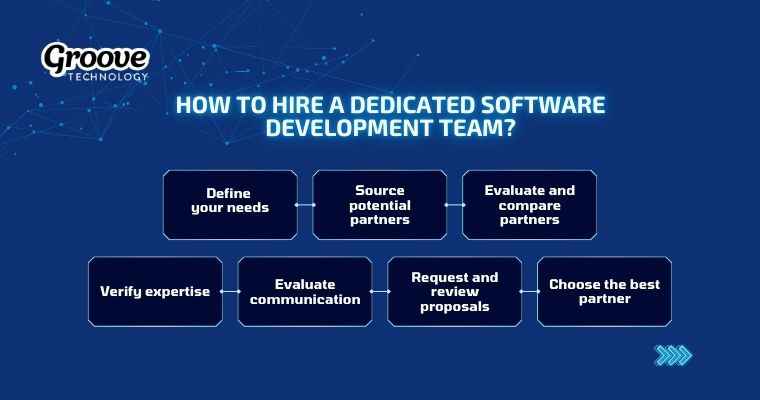
Why Choose Groove Technology's Dedicated Software Development Team?
At Groove Technology, our dedicated software development teams are designed to provide seamless integration, transparency in costs, and top-tier engineering talent. This ensures that your projects are delivered efficiently, on time, and with uncompromised quality. There are three reasons why our teams stand out from the rest.
- Easy On-boarding: We make the onboarding process simple, ensuring smooth integration with your existing practices, whether you use Agile, Scrum, Kanban, or any other framework. Our software engineers actively listen to your needs, addressing all questions and bridging any gaps between expectations and outcomes.
- Transparent Cost Management: We prioritize financial transparency by providing detailed cost breakdowns and performance incentives, offering a clear understanding of your investment. All costs are finalized upfront, with flexibility to adjust as your project scales and evolves.
- Quality Assurance: Our software developers are selected through a rigorous recruitment process to ensure they meet high technical standards while maintaining a positive, proactive attitude. We focus on long-term partnerships, driving continuous training and development to sustain and improve the quality of our resources, ensuring that your project receives the best talent available.

How Much Does Hiring a Dedicated Software Team at Groove Technology Cost?
The outsourcing software development cost at Groove Technology can vary depending on four factors:
- Team size: Larger teams naturally incur higher costs due to the number of developers and roles required to complete the project.
- Developers' location: The location of the developers plays a significant role in cost, as rates differ between regions.
- Level of expertise and position: More experienced developers or those in specialized roles may increase the cost due to their expertise.
- Scope and duration of the project: The complexity and length of the project will influence the total cost, as longer or more intricate projects demand more resources and time.
However, hiring a dedicated software development team is still much cheaper and faster than independently searching for each professional through an in-house HR team. Fill out the contact form to get a fast quote from Groove Technology.
The cost of hiring a dedicated software team from Groove Technology depends on several factors
What does Groove Technology’s Dedicated Software Development Team Technology Stack Include?
Groove Technology’s dedicated software development team utilizes a comprehensive technology stack to ensure optimal performance and scalability. We offer 11 lists of tools and frameworks across various domains, allowing us to tackle any project requirement with precision.
- Back End: .NET, Node.js, Python
- Front End: Angular, CSS, Ember.js, HTML5, JavaScript (JS), Meteor, React, Vue.js
- Mobile: Android, Flutter, iOS, PWA (Progressive Web Apps), React Native, Xamarin
- Clouds: AWS (Amazon Web Services), Azure, DigitalOcean, Google Cloud, Rackspace
- Relational Databases: Amazon RDS, Azure SQL Database, Google Cloud SQL, MySQL, Oracle, PostgreSQL, SQL Server
- Big Data / NoSQL: Amazon DocumentDB, Amazon DynamoDB, Cassandra, Amazon Redshift, Apache Hive, Apache Kafka, Apache Spark, Apache ZooKeeper, Amazon ElastiCache, Azure Blob Storage, Azure Cosmos DB, Azure Data Lake, Google Cloud Datastore, Apache Hadoop, HBase, MongoDB
- DevOps: Ansible, Chef, Docker, Kubernetes, Mesos, OpenShift, Packer, Puppet, SaltStack, Terraform
- CI/CD Tools: AWS Developer Tools, Azure DevOps, TeamCity, Jenkins, Travis CI, Google Developer Tool, Github Action
- Monitoring: Datadog, Elasticsearch, Grafana, Nagios, Prometheus, Zabbix
- Test Automation Tools: Apache JMeter, Appium, Cucumber (CUIT), FMBT (Free Model-Based Testing), HP QuickTest Professional (QTP), Postman, Protractor, Ranorex, Selenium (Se), TestComplete, TestStack.White, Unified Functional Testing (UFT), XCTest
- Information Security: Acunetix, Burp Suite, Cloudflare, Masscan, Metasploit, Nessus, Nmap, OpenVAS (RADAR), SIEGE
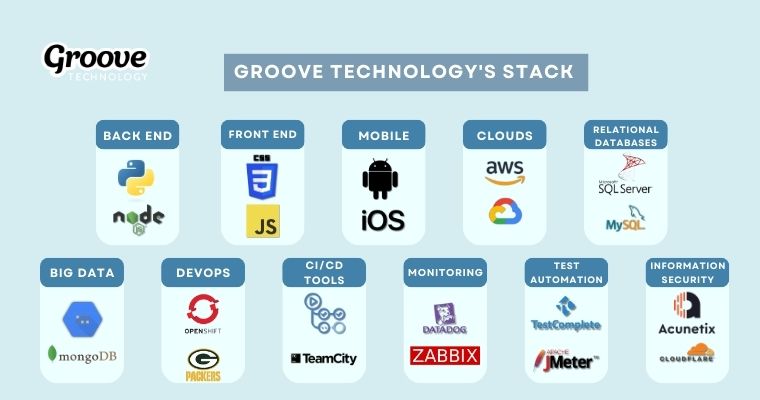
FAQs
What is the difference between an extended team and a dedicated team?
A dedicated software development team is a group of skilled experts aligned to work exclusively on a client's project, full-time, from a provider’s office located in a nearshore area. This team is committed solely to the client’s needs, ensuring focused and uninterrupted progress.
What is the difference between a dedicated team and staff augmentation?
A dedicated team works best for complex projects that require consistent attention, while staff augmentation fills gaps in your existing team when you need more professionals. For ongoing support across multiple projects, outsourcing is the ideal solution.
How many developers should be in a development team?
Typically, the most efficient team size ranges from four to six developers. This ensures comprehensive coverage of all key areas with enough redundancy to maintain productivity and efficiency.
Does it take a long time to get started with Groove Technology's dedicated team service?
Not at all! After you reach out to us, we’ll touch base with you within 24 hours. Depending on what you need and the talent we have available, we can usually get started within 1 to 3 weeks.
This article explored the benefits and considerations of hiring a dedicated software development team, focusing on how Groove Technology can provide a strategic advantage for businesses. Additionally, we outlined how businesses can hire the right team and the costs involved in the process. By providing this article, Groove Technology aims to help businesses make informed decisions about outsourcing software development, ensuring effective project management and high-quality solutions.
For further inquiries or to get started with Groove Technology, simply fill out the contact form on our website. We are ready to assist you with your software development needs.
Related Articles:
- Explore The Best Outsourced Software Company in 2025
- Why Your Travel Business Needs a Dedicated Travel Software Development Team
- The Benefits of Hiring a Dedicated Real Estate App Developer for Your Property Business







